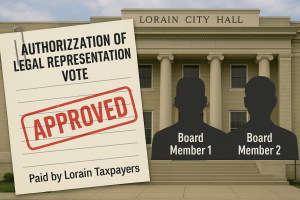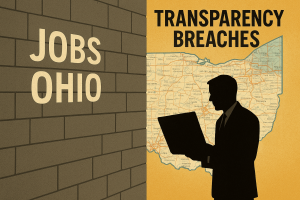Buried Truths: How Lorain County Bulldozed Elyria Township’s Voice to Push a $924K Sewer Deal

May 09, 2025
By Aaron Knapp | Lorain Politics Unplugged

I. A Sewage Mandate With No Public Vote
In January 2025, the Lorain County Board of Commissioners approved a $924,000 sewer project in Elyria Township without a public referendum. The plan, formally referred to as the Lake Avenue Sewer Extension, was awarded to DiGioia Suburban Excavating LLC after a competitive bidding process. The cost, scope, and mandatory compliance timeline imposed on residents sparked alarm and opposition. Homeowners across the affected area received notices requiring them to tie into the sewer within nine months, or face enforcement measures.
Thanks for reading Aaron’s Substack! Subscribe for free to receive new posts and support my work.
The project wasn’t initiated in response to public demand. Rather, it was introduced from the top down, structured around a Tax Increment Financing (TIF) agreement linked to the Carvana Inspection Center and projected development at the Spiegelberg Orchard site. While the infrastructure may eventually benefit developers, the immediate burden fell squarely on local residents, many of whom had recently installed compliant septic systems.
Lorain County Public Health (LCPH) issued the enforcement letters citing health department mandates. But conspicuously absent was any mention of the fact that under LCPH’s own rules, homeowners with functioning and legally installed sewage treatment systems (STS) could request a delay in connecting for up to seven years. This omission raised serious concerns about informed consent and procedural fairness.
Homeowners began to ask questions. If their systems were installed recently and were not deemed a public health nuisance, why the rush to force compliance? The lack of meaningful answers from public agencies only deepened public suspicion. What residents discovered was a well-organized infrastructure push cloaked in regulatory urgency—without the transparency and flexibility promised by the county’s own guidelines.
This began what would become a months-long fight between citizens and government agencies over their right to question, delay, or block a public project that directly affected their homes and finances. The lack of a formal public vote or even a public hearing before the approval of the funding package became a lightning rod for community outrage.
To many, this felt like taxation without representation in modern form: a development-driven project funded by public dollars, forced onto working-class residents, without so much as a ballot.
II. Residents Mobilize—and Are Procedurally Denied
In response to the project approval and tie-in demands, residents organized. Following Ohio law, they prepared and submitted a petition to the Lorain County Board of Elections (BOE) in an effort to halt or modify the sewer project. The initial submission was rejected over a clerical flaw. Rather than abandon the effort, organizers corrected the issue and submitted a revised version well within the statutory time frame.
However, after this second submission, the BOE went silent. No feedback, no objections, no communication. Residents assumed that their corrected petition would be processed and evaluated. Instead, the BOE waited until the statutory deadline expired—and then issued a formal denial of the petition on the grounds that it lacked a required map.
Legally, this basis for denial was valid. Ohio Revised Code mandates the inclusion of a territorial map with such petitions. Yet the BOE had received the filing in advance of the deadline and had ample time to notify petitioners of the deficiency. Their failure to do so effectively guaranteed that the petition would be rejected without remedy.
The community viewed this as not just bureaucratic negligence but a deliberate effort to suppress civic participation. Residents had acted in good faith, followed procedures, and relied on the reasonable expectation that the BOE would at least alert them to any critical omissions. Instead, they were met with silence and eventual rejection.
This lack of transparency and procedural fairness stood in stark contrast to the formal bidding process that contractors received. For them, there were guidelines, checklists, and direct communication. For residents? A procedural dead end.
The BOE’s failure to proactively assist petitioners reflected a systemic imbalance—where institutional actors facilitated the interests of vendors and government partners, but left ordinary citizens to navigate a deliberately complex process with no help or recourse.
Had the BOE simply informed the petitioners about the missing map, the error could have been corrected quickly. But by allowing the filing deadline to pass without communication, the BOE effectively disqualified the petition while avoiding the appearance of direct obstruction.
This pattern raised broader concerns about how administrative processes are used—not to serve democratic engagement, but to nullify it quietly and without appeal.
The urgency behind the Lake Avenue sewer project becomes more understandable when viewed through the lens of development politics and fiscal structuring. The project is largely backed by a Tax Increment Financing (TIF) deal that redirects future tax revenue to repay upfront infrastructure costs—a model commonly used to spur commercial growth. In this case, the TIF is connected to the Carvana Inspection Center and planned development on the former Spiegelberg Orchard site.
TIF districts create strong incentives for municipalities to prioritize infrastructure completion on accelerated timelines. Until the sewer system is completed and operational, adjacent parcels may be considered less viable for commercial development. For large investors and developers, delays translate into financial risk and uncertainty.
This creates a political climate where pressure mounts not just from within local government but from external economic actors. The faster the infrastructure is completed, the sooner the return on investment flows in. And unlike school funding or other citizen-driven priorities, TIF projects often bypass public input.
Officials have a financial interest in seeing the project succeed quickly. With millions of future tax dollars on the line, the stakes extend far beyond septic systems. Residents become collateral in a broader economic gamble—a gamble they were never invited to join.
No formal public forum was held to discuss the TIF’s local impact or how it would intersect with residential property rights. There was no public vote on whether to prioritize this form of subsidized commercial growth over gradual residential adaptation.
The infrastructure planning appeared to proceed backward: first, obligate the funding mechanism, then force compliance from those it affects. The public health rationale may exist, but it was clearly bundled with a parallel goal of securing development-readiness for commercial partners.
The rush to build had less to do with failing septic tanks and more to do with future investors and developers awaiting greenlit utility access. The result? An infrastructure plan that bulldozed—not just land—but community rights and procedural fairness.
If the project was truly about long-term public health and community input, then why not begin with public hearings, notice, and education? Instead, the process was dominated by mandates, omissions, and legal disclaimers.
Understanding the “why” behind the urgency reframes the entire dispute. This wasn’t just a project gone wrong. It was a calculated acceleration of infrastructure to meet commercial goals—with residents bearing the burden in silence.
III. The Board of Elections’ Duty to Assist Petitioners
Under Ohio law, the Board of Elections (BOE) holds significant responsibilities in overseeing election processes, including the review and certification of petitions. While the law mandates that petitions must be complete and accurate upon submission, it also entrusts the BOE with the duty to guide and inform petitioners about the requirements and procedures involved.
According to the Ohio Revised Code §3501.11(K), the BOE is tasked with reviewing, examining, and certifying the sufficiency and validity of petitions and nomination papers. This role inherently includes providing clear instructions and information to petitioners to facilitate compliance with legal requirements. Moreover, the Ohio Secretary of State’s Election Official Manual emphasizes the importance of boards being helpful to potential candidates and issue petitioners, suggesting that boards should provide guidance on the proper methods of conducting elections and the necessary steps for petition filings.
In the case of the Elyria Township sewer project, residents submitted a petition to challenge the project’s implementation. The BOE rejected the petition due to the absence of a required map, a technicality that, while legally justifiable, raises concerns about the board’s role in assisting petitioners. Given the BOE’s responsibilities, it would have been reasonable and within their purview to inform the petitioners of the missing component, allowing them the opportunity to rectify the omission before the filing deadline.
The lack of proactive communication from the BOE in this instance suggests a deviation from their duty to assist and guide petitioners. While the board is not obligated to pre-approve or pre-check petitions, providing general information about common pitfalls or missing elements does not constitute a pre-check but rather fulfills their role in ensuring transparent and accessible electoral processes.
Furthermore, the Ohio Secretary of State’s directives encourage boards to offer resources and guidance to petitioners. By failing to notify the Elyria Township residents of the missing map, the BOE missed an opportunity to uphold the spirit of these directives, potentially undermining public trust in the electoral process.
In conclusion, while the BOE acted within the strict letter of the law by rejecting the incomplete petition, their inaction in assisting the petitioners contradicts the broader responsibilities entrusted to them. Ensuring that citizens are adequately informed and guided through the petition process is essential for maintaining a fair and democratic system.
IV. The Overlooked Seven-Year Exemption
Lorain County Public Health (LCPH) enforces Ohio’s sewage treatment regulations, including provisions that allow homeowners to delay connecting to a sanitary sewer under specific conditions. According to the Ohio Administrative Code and LCPH’s local rules, homeowners with a properly functioning and compliant Sewage Treatment System (STS) may be eligible for a seven-year exemption from mandatory sewer connection.
To qualify for this exemption, the STS must meet the following criteria:
- The system has been installed, operated, and maintained in accordance with Section 3701-29 of the Ohio Administrative Code and LCPH’s local sewage treatment system rules.
- The property owner is not under orders from LCPH to repair, replace, or abandon the STS for reasons other than a sanitary sewer connection.
- The STS is not creating a public health nuisance, as defined in Ohio Revised Code §3718.011.Justia Law+1City of Shelby, Ohio+1
- The homeowner has formally requested and received approval from LCPH for the delay.
Despite these provisions, many Elyria Township residents were unaware of the exemption when they received notices mandating sewer connection. The notifications did not mention the possibility of a delay, leaving homeowners uninformed about their rights. This lack of communication from LCPH prevented residents from exploring legal avenues to postpone the connection requirement.
The omission is particularly concerning given that some homeowners had recently installed new STS systems in compliance with all regulations. For these individuals, the sudden mandate to connect to the sewer system imposed unnecessary financial and logistical burdens.
LCPH’s failure to inform residents about the seven-year exemption undermines the intent of the regulation, which is to provide flexibility for homeowners with compliant systems. By not proactively communicating this option, LCPH neglected its responsibility to ensure that residents are fully aware of their rights and obligations under the law.
This situation highlights the need for greater transparency and outreach from public health authorities. Ensuring that residents are informed about all available options is essential for maintaining trust and compliance within the community.
Moving forward, LCPH should review its communication strategies to ensure that critical information, such as exemptions and rights, is clearly conveyed to affected residents. Providing comprehensive guidance can help prevent similar issues and promote more equitable enforcement of public health regulations.
V. Why the Rush? Development Dollars and Quiet Deals
The urgency behind the Lake Avenue sewer project becomes more understandable when viewed through the lens of development politics and fiscal structuring. The project is largely backed by a Tax Increment Financing (TIF) deal that redirects future tax revenue to repay upfront infrastructure costs—a model commonly used to spur commercial growth. In this case, the TIF is connected to the Carvana Inspection Center and planned development on the former Spiegelberg Orchard site.
TIF districts create strong incentives for municipalities to prioritize infrastructure completion on accelerated timelines. Until the sewer system is completed and operational, adjacent parcels may be considered less viable for commercial development. For large investors and developers, delays translate into financial risk and uncertainty.
This creates a political climate where pressure mounts not just from within local government but from external economic actors. The faster the infrastructure is completed, the sooner the return on investment flows in. And unlike school funding or other citizen-driven priorities, TIF projects often bypass public input.
Officials have a financial interest in seeing the project succeed quickly. With millions of future tax dollars on the line, the stakes extend far beyond septic systems. Residents become collateral in a broader economic gamble—a gamble they were never invited to join.
No formal public forum was held to discuss the TIF’s local impact or how it would intersect with residential property rights. There was no public vote on whether to prioritize this form of subsidized commercial growth over gradual residential adaptation.
The infrastructure planning appeared to proceed backward: first, obligate the funding mechanism, then force compliance from those it affects. The public health rationale may exist, but it was clearly bundled with a parallel goal of securing development-readiness for commercial partners.
The rush to build had less to do with failing septic tanks and more to do with future investors and developers awaiting greenlit utility access. The result? An infrastructure plan that bulldozed—not just land—but community rights and procedural fairness.
If the project was truly about long-term public health and community input, then why not begin with public hearings, notice, and education? Instead, the process was dominated by mandates, omissions, and legal disclaimers.
Understanding the “why” behind the urgency reframes the entire dispute. This wasn’t just a project gone wrong. It was a calculated acceleration of infrastructure to meet commercial goals—with residents bearing the burden in silence.
VI. Why the Rush? Development Dollars and Quiet Deals
The urgency behind the Lake Avenue sewer project becomes more understandable when viewed through the lens of development politics and fiscal structuring. The project is largely backed by a Tax Increment Financing (TIF) deal that redirects future tax revenue to repay upfront infrastructure costs—a model commonly used to spur commercial growth. In this case, the TIF is connected to the Carvana Inspection Center and planned development on the former Spiegelberg Orchard site.
TIF districts create strong incentives for municipalities to prioritize infrastructure completion on accelerated timelines. Until the sewer system is completed and operational, adjacent parcels may be considered less viable for commercial development. For large investors and developers, delays translate into financial risk and uncertainty.
This creates a political climate where pressure mounts not just from within local government but from external economic actors. The faster the infrastructure is completed, the sooner the return on investment flows in. And unlike school funding or other citizen-driven priorities, TIF projects often bypass public input.
Officials have a financial interest in seeing the project succeed quickly. With millions of future tax dollars on the line, the stakes extend far beyond septic systems. Residents become collateral in a broader economic gamble—a gamble they were never invited to join.
No formal public forum was held to discuss the TIF’s local impact or how it would intersect with residential property rights. There was no public vote on whether to prioritize this form of subsidized commercial growth over gradual residential adaptation.
The infrastructure planning appeared to proceed backward: first, obligate the funding mechanism, then force compliance from those it affects. The public health rationale may exist, but it was clearly bundled with a parallel goal of securing development-readiness for commercial partners.
The rush to build had less to do with failing septic tanks and more to do with future investors and developers awaiting greenlit utility access. The result? An infrastructure plan that bulldozed—not just land—but community rights and procedural fairness.
If the project was truly about long-term public health and community input, then why not begin with public hearings, notice, and education? Instead, the process was dominated by mandates, omissions, and legal disclaimers.
Understanding the “why” behind the urgency reframes the entire dispute. This wasn’t just a project gone wrong. It was a calculated acceleration of infrastructure to meet commercial goals—with residents bearing the burden in silence.
VII. Final Thought: The Paper Trail of Power
At the center of this controversy is a simple truth: rules were followed selectively, and silence was weaponized. The Lorain County Board of Elections had the power to notify petitioners of a correctable error. They chose not to. Lorain County Public Health had the option to disclose a seven-year exemption to frightened homeowners. They omitted it.
When public institutions act in ways that obscure citizen rights while accelerating private development, it undermines more than process—it erodes democracy itself. The refusal to help residents understand or exercise their rights doesn’t just reflect bureaucratic coldness. It suggests intent.
This sewer project was more than pipes and permits. It was a revealing case study in how systems can be manipulated to prioritize speed over transparency, and development over deliberation. Residents tried to push back using every tool the law allowed. They were denied at each turn—quietly, legally, and with procedural precision.
What remains is a community left to foot the bill, financially and emotionally, for a project they neither approved nor had fair opportunity to challenge. When governments abandon their duty to inform and support those they govern, trust collapses.
If we are to fix this, it won’t be through more silence. It will come through exposure, accountability, and a public insistence that governance must include the governed.
Legal Disclaimer:
The content of this article is based on publicly available records, documented correspondence, and first-hand reporting. All factual assertions are supported by official documents, government communications, or publicly accessible legal materials. This publication does not offer legal advice and should not be construed as such. Any legal interpretations presented are for informational purposes only. Readers are encouraged to consult appropriate legal professionals or official sources for advice regarding their specific situations. The author and publisher make no representations as to the accuracy or completeness of any information beyond the sources cited.





